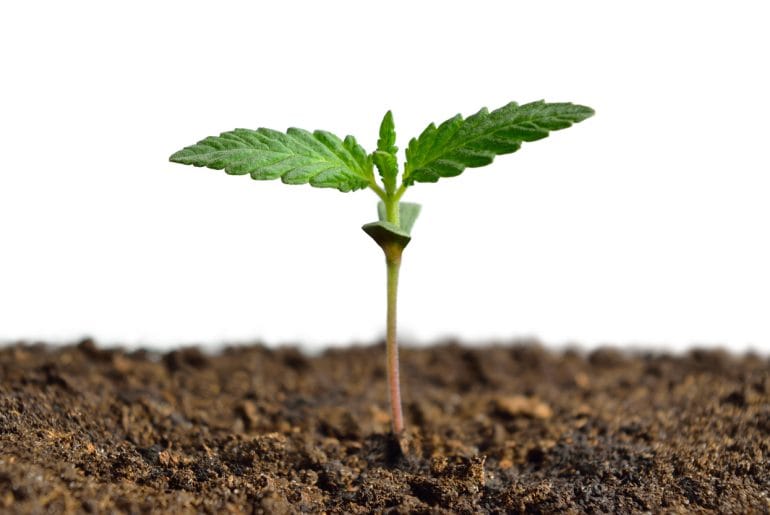Cannabis cultivation at home can be extremely fun, rewarding, and a great way to pass some time as you work through the cannabis growth stages, particularly of the female cannabis plant.
Furthermore, when everything is said and done, you also have your own crop to consume. Sometimes, there’s just nothing better than smoking your own homegrown marijuana, because you know exactly what went into it.
With that being said, growing marijuana at home can also be somewhat complex, as there are many different factors that you need to take into account, with nutrients, temperature, relative humidity, and lighting being just some of them, among many others.
However, as long as you keep all of these factors in check, you should have no problems growing a healthy cannabis plant at home, even if we are talking about just a few plants.
One of the most important things that you therefore need to know are what the different stages of marijuana plant growth are, the so-called cannabis plant life cycle.
Technically speaking, there are four main stages of marijuana plant growth, which include germination, seedling, the vegetative stage, and the cannabis flowering stage.
Today, we want to take a closer look at each of these four stages of marijuana plant growth in the form of an ultimate guide so you can grow your own healthy cannabis plant.
We’re going to tell you all of the most important points that you need to know about each of these four growth stages to produce a successful marijuana crop several months down the line. Let’s take a look at the different cannabis growth stages right now!
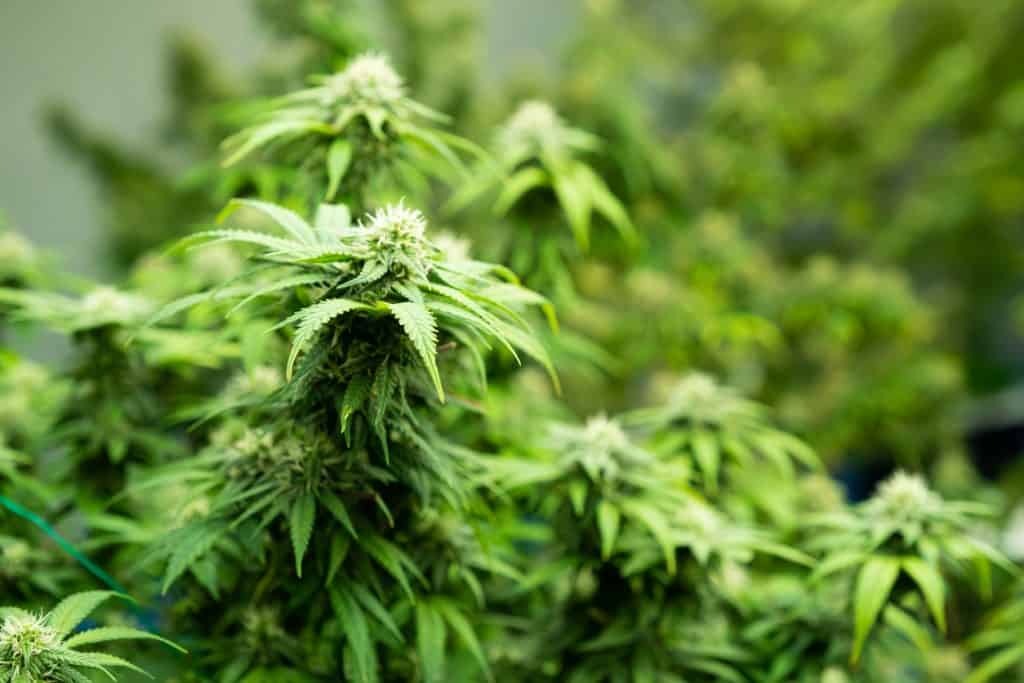
Germination of a Cannabis Seed
If you plan on a successfully growing your own cannabis, the very first thing that you will need to do is to germinate the seeds.
The germination process involves causing the cannabis seed to sprout or crack open, therefore exposing its inner components to the outside soil or growing medium.
When a cannabis seed opens up, the sprout and the taproot emerge, which is effectively the beginning of plant growth.
You cannot grow any type of plant, whether cannabis or otherwise, without first germinating the seed. This is perhaps one of the most critical stages in marijuana plant growth, as it often dictates how healthy and productive a plant will be.
One thing to note however is that damaged or old cannabis seeds may not germinate.
Sure, if you purchase high quality seeds from a reputable seed bank, the germination rate should be anywhere between 90% and 100%.
However, if you just have seeds that you found at home, such as in older cannabis crop, only about half of these may sprout, given that they are not damaged.
What you also need to be aware of is that light, temperature, and relative humidity all affect how long cannabis seeds stay good for.
If you want your cannabis seeds to stay in the top condition for as long as possible, you need to keep them in a cool, dark, and relatively dry place with a humidity level range between 40% and 60%.
If properly stored, such as in a dark area in your refrigerator, cannabis seeds may stay viable for up to 10 years.
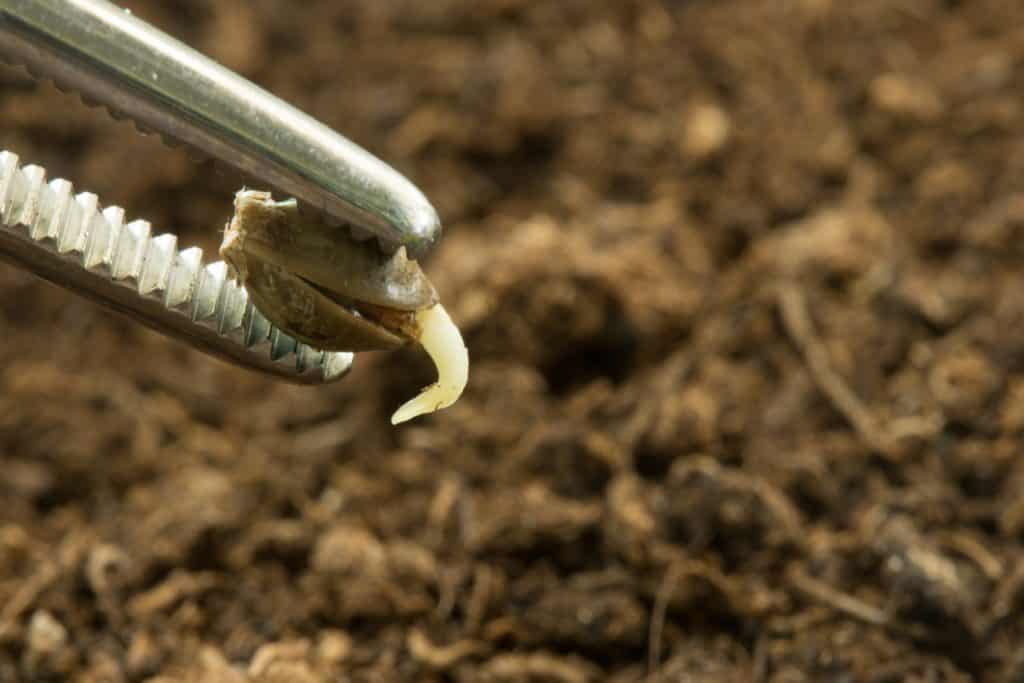
Cannabis Seeds Germination Guide
Seeing as this process is so important to the overall success of your cannabis growing process, let’s provide you with a detailed and step by step tutorial on exactly how to get those cannabis seeds to sprout.
First things first, you have to choose high quality cannabis seeds that you find at a reputable source.
You want seeds that are relatively dark, have a hard shell, are mature, and undamaged. Your best bet is to purchase them from a reputable seed bank, and you also want to look for feminized seeds, as this will or that you get e-mail cannabis plants.
Next, one of the most important components of germinating a cannabis seed is some moisture.
Moisture will cause the shell of the cannabis seed to start to crack open, and will provide the seed with the beginnings it needs to start growing.
Many people choose to simply soak the seed in big glass of water for up to 24 hours, although this may drown the seed.
A better method is to take the seed and place it inside of a damp paper towel, as this will allow you to control the moisture levels. It’s all about softening the shell of the seed to kick start the germination process.
The Germination Medium
You then need to choose the germination medium. Some people simply leave the seeds inside of the wet paper towel, but others may put the seeds inside pre moistened soil, cubes of rockwool, or peat cubes.
Remember that this growing medium needs to be kept fairly moist, but not too wet. You want the roots to be able to absorb water without drowning.
The Environment
The next important thing to remember here is that cannabis seeds generally do best in dark and warm environments, as far as germination stage is concerned.
Therefore, you always want to keep the seeds away from excessive sunlight, so keeping them in a dark cabinet or drawer is recommended, especially if you are germination method that does not block out light.
You then also want to ensure that the temperature is kept between 68 and 77 degrees Fahrenheit, or roughly between 20 and 25 degrees Celsius.
Depending on the germination method that you are using, it may take anywhere between 24 hours and seven days for the germination stage to complete, although somewhere around three or four days is pretty average.
When you see the top root or seedling emerging, which usually takes the form of a very small white growth, you know that your cannabis seeds are ready to be planted into the growing medium.
Transplanting the Seedling
This brings us to the next point, transplanting, which is required once your cannabis plant begins have a healthy tap root or have emerged from the shell of the seed.
You need to very carefully take these sprouts, which are technically now known as seedlings, and place them in the growing medium, such as soil or a hydroponic system.
At the very most, the germination stage should last no more than 10 days. This brings us to the next and second growth stage of cannabis, the seedling stage.
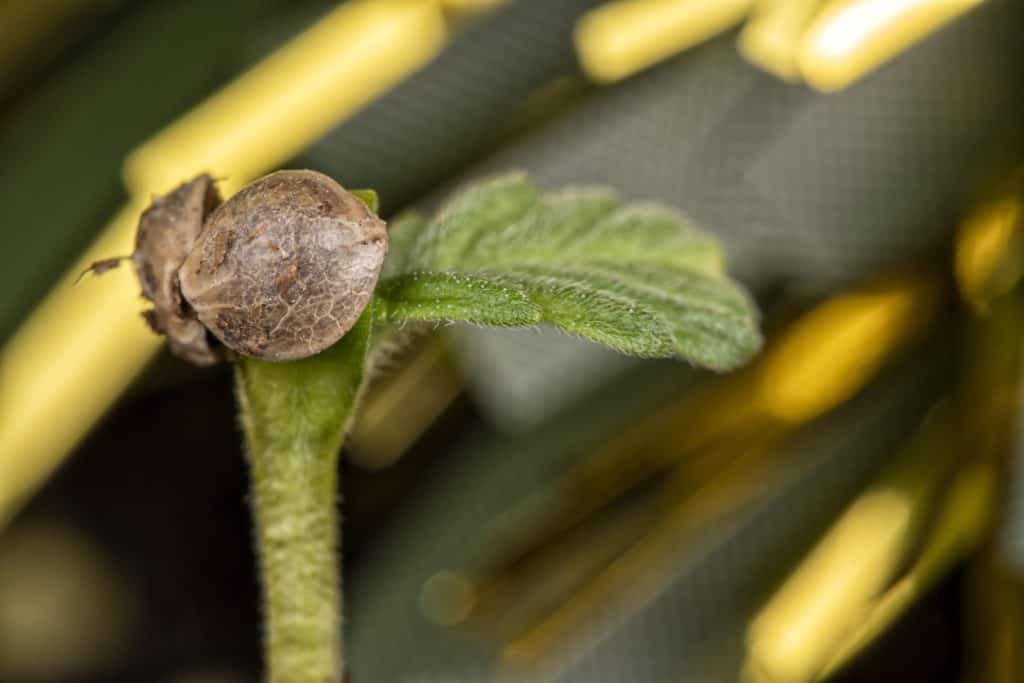
Weed Plant Stages – The Seedling
We then have the seedling stage of cannabis growth, which you could consider the toddler years for your cannabis plant.
This seedling stage usually lasts anywhere from when the plant sprouts to roughly three weeks into the process.
This is of course one of the earliest stages of growth in the life cycle of the cannabis plant, and it happens right after a successful germination stage.
Here, you will see cotyledons present, which are the initial leaves.
These first leaves are responsible for providing the cannabis plant with energy that the seedling needs until it is able to develop its first true leaves, so it can start performing photosynthesis.
After the cotyledons, the seedling should start growing its first set of true leaves, which start looking like those classic fan shaped leaves that weed plants are known for.
These are the leaves that are responsible for performing photosynthesis, which helps to convert light into energy to help fuel the growth of the cannabis plant. This stage is therefore very important.
During this stage, the stem of the cannabis plant will also start to develop, both elongating and thickening, which will help provide support to all of the emerging leaves and flowers later on down the line.
At the same time, as the plant grows, the roots of the cannabis will also develop.
The roots will start to branch out and extend, to provide the cannabis plant with a solid anchor in the growing medium, as well as to absorb nutrients and water.
Here, you will also see the seedling starting to emerge out of the growing medium, and start to grow above the surface.
This is an early growth phase and here the plant is extremely vulnerable, and therefore requires proper care. Providing it with adequate nutrients, light, water, and other growing conditions is essential.
How to Take Care of a Cannabis Seedling
As mentioned above, cannabis seedlings are very delicate, which means that you need to provide them with appropriate conditions to survive.
Below you will find a list of the most important factors to keep in mind when caring for a cannabis seedling.
- You always need to provide your cannabis seedlings with the appropriate amount of light. Seedlings are still very fragile, so that although they need a lot of light, it has to be indirect.
- You don’t want to provide the seedlings with too much direct light, or else they may suffer light burn and heat stress.
- Using an LED light or fluorescent grow light that has a relatively low wattage level which is placed at a suitable distance, around 20 inches from the plant, is recommended.
- You then need to provide your plant seedling with the proper temperature, which in this case ranges from 68 to 77 degrees Fahrenheit, or about 20 to 25 degrees Celsius.
- This should also be slightly cooler during the night. You absolutely need to avoid any extreme temperature fluctuations, as this may stress out and kill your seedling.
- Cannabis seedlings also prefer relatively high humidity levels, around 75% ideally, which helps to prevent moisture from being lost through the leaves, and this also helps to encourage healthy growth.
- Although you may be tempted to constantly water your cannabis seedling, you have to be careful to not over water it. You need to let the growing medium dry out very slightly between waterings to prevent the roots from becoming waterlogged.
- Waterlogged roots can lead to root rot, and quickly lead to the death of your plant. Therefore, using a very gentle stream of water or even a spray bottle to water your cannabis seedlings is recommended.
- When you transplant the seedling into the growing medium, you want to make sure that the growing medium is an ideal one for cannabis growth.
- This means that you want to use a nutrient rich growing solution that is sterile and well-draining. Using a heavy soil that retains too much water is not recommended here.
- What is important to note is that during this stage, you really don’t need to provide your cannabis seedlings with any nutrients.
- The soil you are using should already increase in it, plus the initial leaves of the cannabis plant should provide enough energy and nutrients for the first few weeks of growth.
- At this point, you also need to make sure that the pH range is somewhere between 5.5 and 6.0.
- Remember that if you do this properly, the seedling will outgrow its initial container, which means that you will need to transplant it into a larger container that is suitable for the vegetative stage of growth. On that note, the next stage of growth is indeed the vegetative stage of growth, which we are about to talk about.
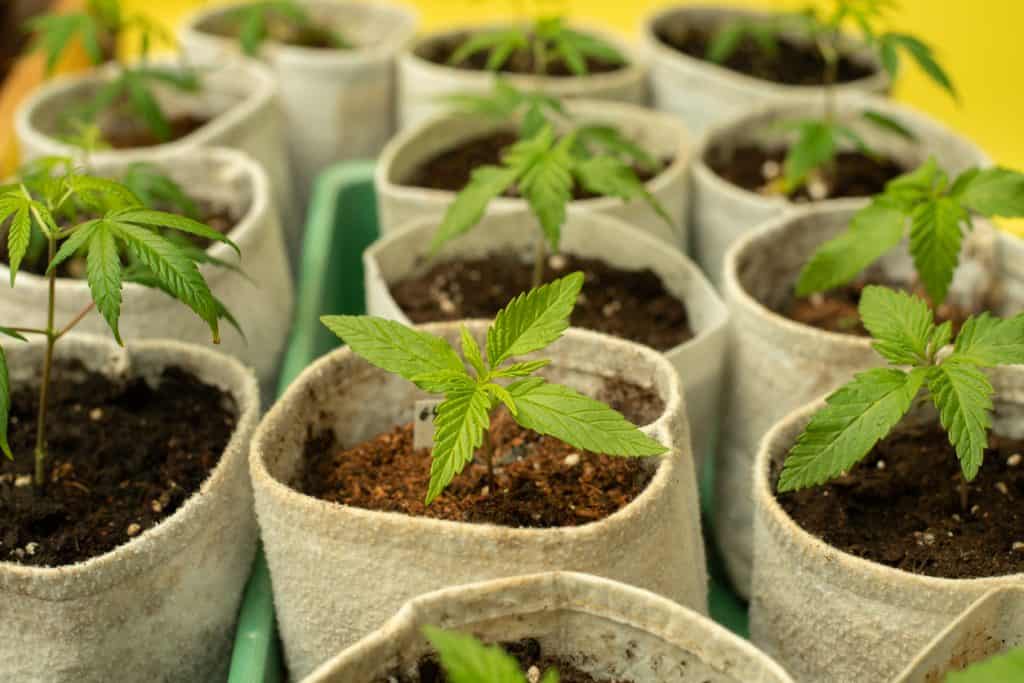
Cannabis Plants in the Vegetative Stage
The third stage of growth in the life cycle of the cannabis plant is the vegetative stage of growth.
This usually starts at about three weeks into the process and may last up until week 16.
This means that until a cannabis plant is done its vegetative stage, it may take up to four months of growth. As you can tell, growing cannabis is quite a lengthy process.
The vegetative stage of cannabis growth is extremely important for a wide variety of reasons.
First and foremost, during the vegetative stage, you will see that the cannabis plant experience vigorous and drastic growth.
The main aim of the vegetative stage of the cannabis plant is to develop very strong stem to greatly increase in size, to develop branches and foliage, and to develop a strong root system.
The cannabis plant must develop a strong stem because this will be required to hold up the branches, the leaves, and all of the flower that will develop during the cannabis flowering stage.
Furthermore, the vegetative stage is also very important for developing all of the foliage and branches, as those leaves are required to allow the plants to perform photosynthesis.
The more big and healthy leaves a cannabis plant has, the more sunlight it can absorb and turn into energy for growth. These leaves are very important.
Just as important is a healthy root system, as this acts as the anchor that holds the plant in place, and also acts as the main delivery method of nutrients and water.
Having a healthy root system is perhaps the most important aspect of all.
Here you will see the cannabis plant growing rapidly, and you’ll start to see the development of full fan leaves.
You’ll also see the stem growing very tall with branches and nodes growing out of those stems.
One of the main features of the vegetative stage is that the cannabis plant produces as many leaves as it can, and these are usually very large and complex.
The side branches will also start to develop, which is where the colas or clusters of buds will start to grow.
You should see the plant experiencing massive vertical and horizontal growth during this stage, as the plant actually aims to reach its near maximum size, so it can then focus on flowering instead of growing more foliage.
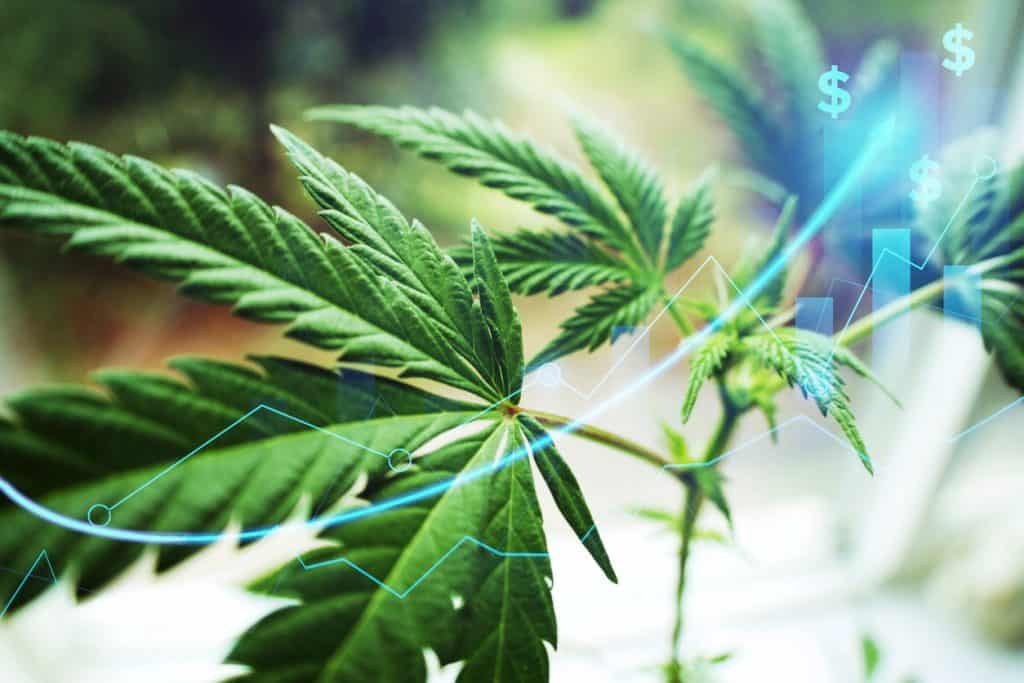
Caring for a Cannabis Plant in the Vegetative Stage
Let’s now go over some crucial tips on how to care for a cannabis plant that is in its vegetative stage.
- You need to provide your cannabis plant with plenty of sunlight during this stage, more than enough to mimic those long summer days.
- Most people choose to provide their cannabis plants with up to 24 hours of sunlight per day, although a minimum of 18 is recommended. You want to use very high quality grow lights, such as T5 fluorescence tubes, metal halide bulbs, LED, fluorescent grow lights, or even HID lights.
- We recommend doing a bit more research into the various types of lights that you can use for this purpose. Make sure to keep the lights between 16 and 24 inches from the plants to prevent them from becoming burnt.
- You’ll have to provide your cannabis plants with plenty of nutrients during this stage, particularly the NPK nutrients, or nitrogen, potassium, and phosphorus.
- During the initial vegetative stage of growth, the number one most important nutrient is nitrogen, as nitrogen is required for the growth of foliage. However, your nutrient solution still needs to be relatively well balanced.
- During this stage of growth, you also need to ensure that the pH level of the watering solution and the soil is typically 5.5 and 6.5, which means that you will need monitoring equipment.
- Cannabis plants in their vegetative stages also require a good deal of water, but you need to be careful to not over water them.
- Therefore, you want to let the grow medium dry out slightly between watering so you don’t overwater the plants. This will help prevent root problems from occurring. Always make sure to test your water from the pH level to avoid any nutrient imbalances.
- Air circulation is also very important, because this helps you control both temperature and humidity, plus it helps prevent issues like mold and mildew from occurring. At the same time, air circulation also helps train the stems to become much stronger.
- One of the other main points to keep in mind is that the temperature needs to be kept between 20 and 28 degrees Celsius, or between 68 and 82 degrees Fahrenheit, with the humidity level being kept between 40% and 60%. Any fluctuations in humidity and temperature should be at all costs.
Flowering Stage
We then have the cannabis flowering stage of cannabis growth, which is when the cannabis plants develops all of its flowers or buds, which is of course what you are aiming for.
Not only is this when the cannabis plant starts to develop all of its buds and flowers come up but more importantly, when the THC, CBD, and all of those other cannabinoids start to develop as well.
A cannabis plant may still grow in height and width during this stage, although most of the growth should be focused on the buds and flowers.
When the flowering stage starts, you will see that the female cannabis plants develop small white hair-like structures that are known as pistils, and these are the first signs of a flower growing.
These will continue to grow and you will see small buds starting to form.
As the buds mature, you will also see trichomes develop, which are very small resinous glands on the surface of the leaves and flowers, which look like very small mushrooms when held under a microscope.
These trichomes are what will develop the cannabinoids, terpenes, and other compounds that are responsible for the effects, flavors, and aromas of the cannabis plant.
This is also a very important stage because it is when you will need to differentiate between male and female plants.
Female plants produce pistils and develop buds, while male cannabis plants produce pollen sacks.
Remember that we want only female plants, so during this flowering phase of the cannabis growth cycle, you need to ensure that you only have females.
You don’t want the male plants pollinating the female plants and causing them to develop seeds, so male plants need to be removed from the grow area as soon as possible.
A male cannabis plant needs to be gotten rid of immediately!
Keep in mind that this flowering stage can start anywhere between 12 and 16 weeks after you start the germination stage your seed, depending on how long the vegetative stage lasts.
The flowering stage may last for another 7 to 12 weeks, depending on the strain in question.
Once most of the trichomes have turned a cloudy or amber color, you’ll know that your cannabis plant is ready for harvest.
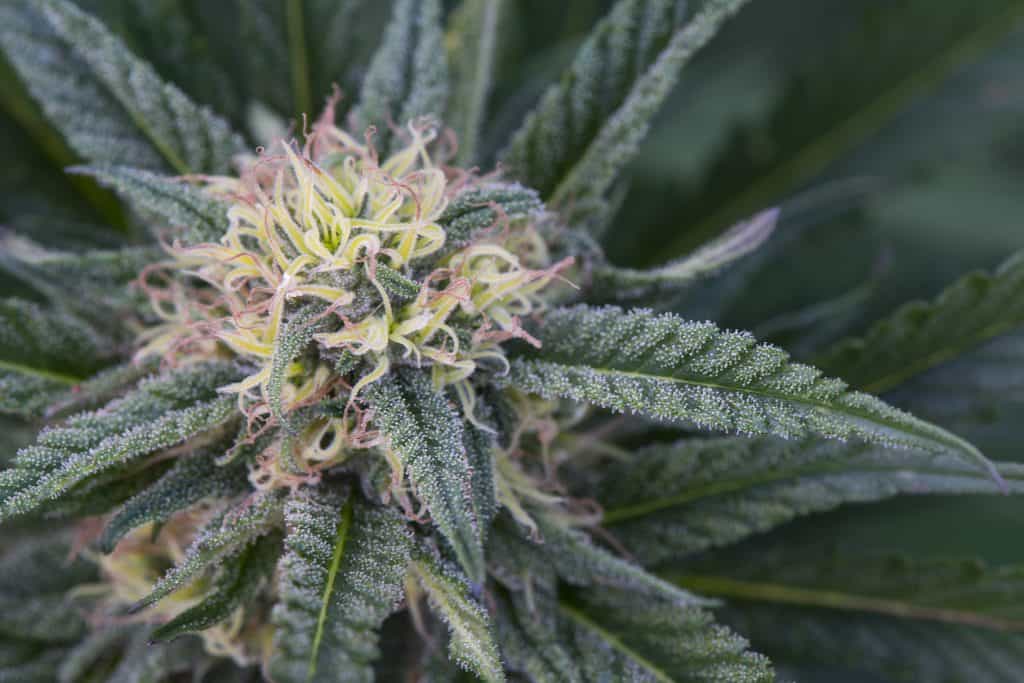
Caring for a Flowering Cannabis Plant
Seeing as you probably want to develop maximum yields and bug potency, let’s go over some tips on how to care for a cannabis plant in its flowering stage.
- To start the flowering stage, you’ll need to switch the light cycle from 24 hours of light per day to 12 hours of light per day.
- Your cannabis plant in its flowering stage needs to get 12 hours of light followed by 12 hours of darkness each day. Using LED or high-pressure sodium lights during this stage is recommended. Getting 12 hours of darkness each night is very important as the plant develops.
- During the flowering stage of growth, the two most important nutrients that your cannabis plants require are potassium and phosphorus, and these are responsible for developing healthy roots, big buds, and high levels of potency. Your plant will still need some nitrogen, but not as much as before.
- During the flowering stage of growth, you need to keep the humidity levels around 45% so that the flowers will not have excess moisture in them. During this time, the temperature should be kept between 68 and 79 degrees Fahrenheit, or around 20 to 26 degrees Celsius, and slightly cooler during the night.
- At this point, you may start using techniques such as defoliation, pruning, and support to help increase the health of your flowering plants, and ultimately to increase the overall yield.
- Once you see that the pistils and trichomes are mature, you know that the cannabis plant is ready to harvest.
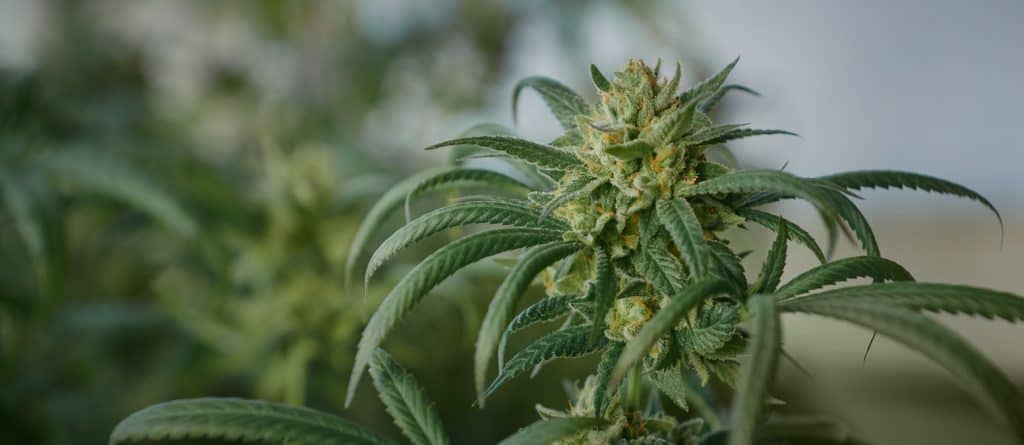
Conclusion
The bottom line here is that there are four main stages of cannabis growth, each of which is more important than the previous one.
If you expect your cannabis plants to produce big buds and a lot of them, you need to take proper care of your cannabis plant during each of those four stages of growth, so that you have a healthy plant, and you need to ensure that you have a female plant!
Using the tips that we have provided you with above, you should be able to get your cannabis plant from seed to harvest without any issue.
Remember that cannabis cultivation requires you to adhere to a strict cannabis growth timeline.
Keep in mind that while growing times may differ, all plants, whether indoor autoflowering plants or outdoor plants, have to go through the cannabis life cycle.
This includes cannabis seed germination, the seedling growth stage, veg growth, flowering cannabis plants, and harvest. There is of course a drying process required as well!

